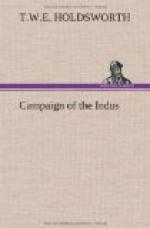We have here certainly the flower of the Bombay army, and a very respectable force in every respect: two of the best European regiments, four of the best native, the 4th dragoons, two regiments of light cavalry, two troops of horse artillery in prime order, and a battalion of foot artillery, together with a splendid band of auxiliary horse from Cutch, the finest looking fellows I ever saw: they arrived here on the same day as ourselves. I was standing on one of the hills as they wound their way round it; I was never struck with anything so much, nor have I ever seen anything so orientally military before. They are dressed in green garments, edged with gold, and red turbans, tied under the chin, like the old Mahratta soldiers; their arms are match-lock, lance, scimitar, and pistols, and they appear to be excellent and practical riders. They are quite an independent corps, each man finding his own horse, arms, accoutrements, &c., and they take good care to be excellently mounted. They have a few European officers attached to them from the Bombay establishment. Their dress is also uncommonly handsome; a green hussar dress, with gold braiding. In addition to all this force, we have a subsidiary one nearly as large, coming on directly to follow our steps, and occupy Sinde, while we march on with the Bengalees for Cabool. This force, they say, is to consist of H.M. 40th regiment from Deesa, the 10th, 16th, 22nd, and 24th regiments, 23rd N.I., together with H.M. 90th and 61st regiments, and Ceylon Rifle Corps (Malays) from Ceylon, so that I expect the government at home will have to send more regiments to India as quickly as possible. Sir J. Keane is very likely to have the command of the whole force, both Bombay and Bengal, as they say Sir H. Fane is gone back to Bengal with half the Bengal force, in consequence of the Burmese declaring war; which, as might have been expected, they did directly when so many regiments were marched from their neighbourhood. This report is, however, contradicted, and they say now that Sir H. Fane is going home, and will meet us at Shikarpoor or Hydrabad, give up the command to Sir J. Keane, and go down the Indus, and thence to England overland. Which is the true version I know not; but I am afraid that I have little chance of meeting Colonel Fane, and giving him Arthur’s letter, which I expected to do when I wrote last. I am delighted at the prospect of our going to Cabool: there we may have some fighting, and have a chance of being permanently quartered till we return to Europe, whenever that may be.
What the original cause of all this was, as I told you before, I hardly know; and you are more likely to get at the true version from some of the Indian newspapers, or from any friends you may have connected with this part of the world, than from me. But, as far as I can learn, this appears to be it: Shah Shooja is the rightful heir to the throne of Cabool, and Dost Mahomed is what Mr. C. Dickens calls




